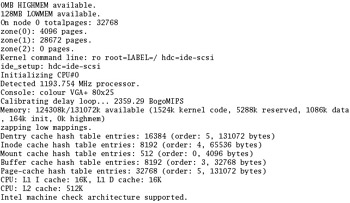Certification Objective 3.02: Postinstallation Validation
|
| < Day Day Up > |
|
Red Hat Enterprise Linux 3 creates a number of files when installation is complete. These files essentially document what happened. The basic installation log file, /root/install.log, lists the packages that Anaconda installed on your system. The boot information is stored in the /var/log/dmesg file. The commands used by Anaconda to install Linux is stored in the /root/anaconda-ks.cfg file. This can serve as a template for the Kickstart process, which you can use to install RHEL 3 automatically on different computers. I describe Kickstart in more detail later in this chapter.
The Installation Log File
The installation log file, /root/install.log, provides a baseline. After you run Linux for some time, you've probably installed and upgraded a number of additional packages. You can refer back to this file to find the packages installed when Linux was installed on this computer.
dmesg Boot Messages
The /var/log/dmesg file contains boot messages duplicated from the console output as seen each time Linux boots. These messages contain hardware information, process initialization, and sequencing information, and more, as shown in Figure 3-1.

Figure 3-1: dmesg boot messages
Graphical or Text Login Screen
After the installation process is complete, the installation script shuts down and reboots the computer. If you configured a graphical login, Linux starts in runlevel 5, the X Window login screen. Alternatively, if you configured a text login, Linux starts in runlevel 3.
| On The Job | If your X Window server is not configured properly, you can press CTRL-ALT-F2 to go back to a text-based login screen. |
It's easy to shift runlevels. The init x command, where x represents the runlevel, modifies the Linux system accordingly. For example, if you have a text login, the init 5 command should move Linux to a graphical login screen, assuming you have the appropriate packages such as GNOME and the X Window System installed. Alternatively, the init 3 command moves Linux to a text login screen.
|
| < Day Day Up > |
|
EAN: N/A
Pages: 194